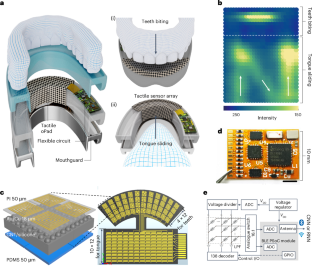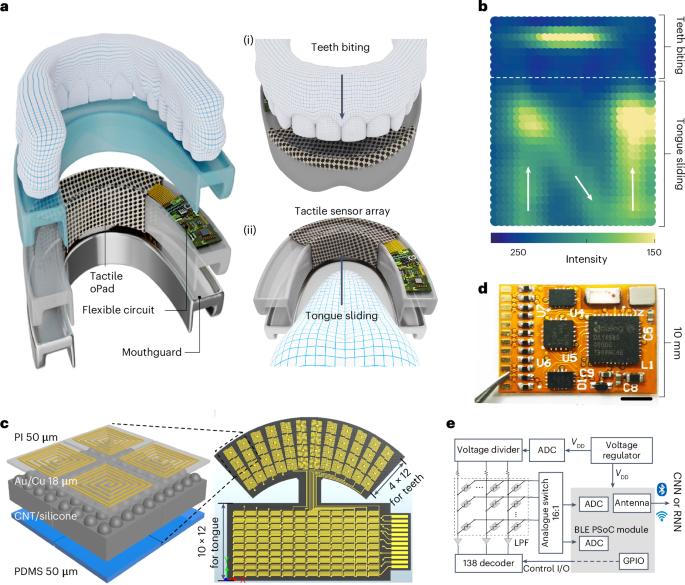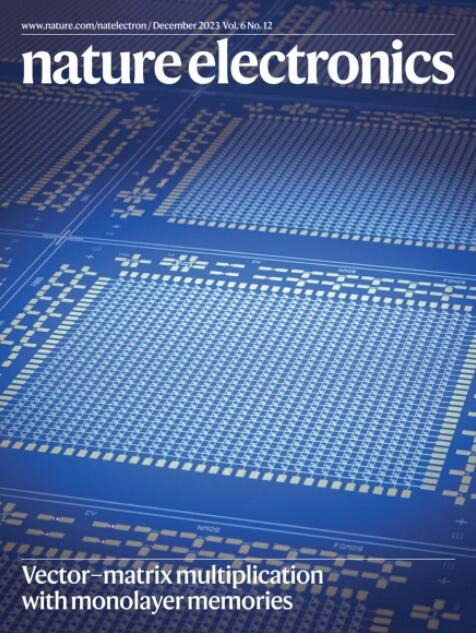基于碳纳米管的触觉口腔垫,用于多模态触觉交互
IF 40.9
1区 工程技术
Q1 ENGINEERING, ELECTRICAL & ELECTRONIC
引用次数: 0
摘要
在生物医学机器人技术的发展过程中,结合了可传输时空触摸模式的软触觉传感器的可穿戴系统可能会大有用武之地。此类系统已被用于打字和设备操作等任务,但它们在将压力模式转换为特定控制命令方面的效果落后于传统的手指操作电子设备。在这里,我们介绍一种带有由碳纳米管和硅树脂复合材料制成的触摸传感器阵列的触觉口腔垫。该口腔垫可通过移动舌头或牙齿进行操作,并能检测到各种应变,因此其功能类似于触摸屏。结合递归神经网络,我们展示了通过舌头滑动(压力低于 50 kPa)和牙齿点击(压力高于 500 kPa)的协同控制,口腔垫可用于打字、游戏和轮椅导航。本文章由计算机程序翻译,如有差异,请以英文原文为准。


A tactile oral pad based on carbon nanotubes for multimodal haptic interaction
Wearable systems that incorporate soft tactile sensors that transmit spatio-temporal touch patterns may be useful in the development of biomedical robotics. Such systems have been employed for tasks such as typing and device operation, but their effectiveness in converting pressure patterns into specific control commands lags behind that of traditional finger-operated electronic devices. Here, we describe a tactile oral pad with a touch sensor array made from a carbon nanotube and silicone composite. The oral pad can be operated by moving either the tongue or teeth, and it can detect various strains so that it functions like a touchscreen. Combined with a recurrent neural network, we show that the oral pad can be used for typing, gaming and wheelchair navigation through cooperative control of tongue sliding (below 50 kPa pressure) and teeth clicking (above 500 kPa pressure). A tactile oral pad made from a carbon nanotube and silicone composite that can be controlled by teeth and tongue movements can be used for typing, gaming and wheelchair navigation.
求助全文
通过发布文献求助,成功后即可免费获取论文全文。
去求助
来源期刊

Nature Electronics
Engineering-Electrical and Electronic Engineering
CiteScore
47.50
自引率
2.30%
发文量
159
期刊介绍:
Nature Electronics is a comprehensive journal that publishes both fundamental and applied research in the field of electronics. It encompasses a wide range of topics, including the study of new phenomena and devices, the design and construction of electronic circuits, and the practical applications of electronics. In addition, the journal explores the commercial and industrial aspects of electronics research.
The primary focus of Nature Electronics is on the development of technology and its potential impact on society. The journal incorporates the contributions of scientists, engineers, and industry professionals, offering a platform for their research findings. Moreover, Nature Electronics provides insightful commentary, thorough reviews, and analysis of the key issues that shape the field, as well as the technologies that are reshaping society.
Like all journals within the prestigious Nature brand, Nature Electronics upholds the highest standards of quality. It maintains a dedicated team of professional editors and follows a fair and rigorous peer-review process. The journal also ensures impeccable copy-editing and production, enabling swift publication. Additionally, Nature Electronics prides itself on its editorial independence, ensuring unbiased and impartial reporting.
In summary, Nature Electronics is a leading journal that publishes cutting-edge research in electronics. With its multidisciplinary approach and commitment to excellence, the journal serves as a valuable resource for scientists, engineers, and industry professionals seeking to stay at the forefront of advancements in the field.
 求助内容:
求助内容: 应助结果提醒方式:
应助结果提醒方式:


